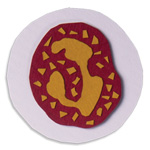THE CELLS OF THE IMMUNE SYSTEM are the body’s shock troops—they race to the scene of a cut or other wound to fight off invading microbes and begin the healing process. But when these potent weapons are directed against the body’s own cells, they can cause serious damage.
|
Scavenging cells that can consume large quantities of invading microbes, macrophages are also leading agitators in the damage caused by chronic inflammation. |
|
These cells are equipped with grenade-like granules that, when released in the vicinity of a targeted cell, blast holes in the cell’s protective membrane. They then send in molecules through these holes that induce the cell to commit suicide. Deficiencies in natural killer cells are associated with multiple sclerosis, lupus, and type 1 diabetes. |
|
Like macrophages, the smaller, more numerous neutrophils specialize in gobbling up toxins and destroying them with high-powered chemical poisons. They predominate in the early stages of the immune response, usually giving way to the macrophages within a few hours. People who don’t have enough neutrophils are highly susceptible to infections. |
|
In their original state, T-cells circulate through the body searching for signs of infection or cancerous growth. When they detect a problem, some T-cells become killer T-cells and launch an attack, while others become helper T-cells, which call in additional specialized immune cells to eradicate the offenders. T-cells are the main force behind almost all autoimmune diseases, including type 1 diabetes, rheumatoid arthritis, and multiple sclerosis. They are also responsible for rejection of transplanted organs and for certain types of allergic reactions. |
 Macrophages
Macrophages Natural killer cells
Natural killer cells Neutrophils
Neutrophils T-cells
T-cells